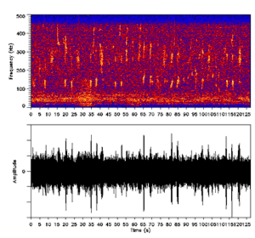Hydrophone

A hydrophone (Ancient Greek ὕδωρ = water[1] and φωνή = sound[1]) is a microphone designed to be used underwater for recording or listening to underwater sound. Most hydrophones are based on a piezoelectric transducer that generates electricity when subjected to a pressure change. Such piezoelectric materials, or transducers, can convert a sound signal into an electrical signal since sound is a pressure wave. Some transducers can also serve as a projector, but not all have this capability, and some may be destroyed if used in such a manner.
A hydrophone can "listen" to sound in air but will be less sensitive due to its design as having a good acoustic impedance match to water, which is a denser fluid than air. Likewise, a microphone can be buried in the ground, or immersed in water if it is put in a waterproof container, but will give similarly poor performance due to the similarly bad acoustic impedance match.
History

The earliest widely used design was the Fessenden oscillator, an electrodynamically driven clamped-edge circular plate transducer (not actually an oscillator) operating at 500, 1000, and later 3000 Hz. It was originally marketed as an underwater telegraph, rather than as sonar, but was later very successful, its Canadian inventor, Reginald Fessenden, was awarded the "Scientific American Magazine Gold Medal of Safety" in 1929 from the American Museum of Safety, an organization for ship captains;[2] some were still in use during World War II.
Ernest Rutherford, in England, led pioneer research in hydrophones using piezoelectric devices, and his only patent was for a hydrophone device. The acoustic impedance of piezoelectric materials facilitated their use as underwater transducers. The piezoelectric hydrophone was used late in World War I, by convoy escorts detecting U-boats, greatly impacting the effectiveness of submarines.
From late in World War I until the introduction of active sonar, hydrophones were the sole method for submarines to detect targets while submerged, and remain useful today.
Directional hydrophones
A small single cylindrical ceramic transducer can achieve near perfect omnidirectional reception. Directional hydrophones increase sensitivity from one direction using two basic techniques:
Focused transducers
This device uses a single transducer element with a dish or conical-shaped sound reflector to focus the signals, in a similar manner to a reflecting telescope. This type of hydrophone can be produced from a low-cost omnidirectional type, but must be used while stationary, as the reflector impedes its movement through water. A new way to direct is to use a spherical body around the hydrophone. The advantage of directivity spheres is that the hydrophone can be moved within the water, ridding it of the interferences produced by a conical-shaped element
Arrays
Multiple hydrophones can be arranged in an array so that it will add the signals from the desired direction while subtracting signals from other directions. The array may be steered using a beamformer. Most commonly, hydrophones are arranged in a "line array" but may be in two- or three-dimensional arrangements.
SOSUS hydrophones, laid on the seabed and connected by underwater cables, were used, beginning in the 1950s, by the U.S. Navy to track movement of Soviet submarines during the Cold War along a line from Greenland, Iceland and the United Kingdom known as the GIUK gap.[3] These are capable of clearly recording extremely low frequency infrasound, including many unexplained ocean sounds.
See also
Notes
- 1 2 Liddell, H.G. & Scott, R. (1940). A Greek-English Lexicon. revised and augmented throughout by Sir Henry Stuart Jones. with the assistance of. Roderick McKenzie. Oxford: Clarendon Press.
- ↑ Frost, Gary Lewis (July 2001). "Inventing Schemes and Strategies: The Making and Selling of the Fessenden Oscillator". Technology and Culture. Project MUSE. 42 (3): 462–488. doi:10.1353/tech.2001.0109. External link in
|publisher=(help) - ↑ Mackay, D.G. "Scotland the Brave? US Strategic Policy in Scotland 1953-1974". Glasgow University, Masters Thesis (research). 2008. Accessed 12 October 2009.
References
- Pike, John (1999). SOSUS. Retrieved January 28, 2005.
- Watlington, Frank (1979). How to build & use low-cost hydrophones. (ISBN 0830610790)
- Unknown. hydrophone. Retrieved January 28, 2005.
- Unknown. (2005) Schlumberger Oilfield Glossary: Term 'hydrophone'. Retrieved January 28, 2005.
- Onda Corporation (2015). 'Hydrophone Handbook'.
External links
| Wikimedia Commons has media related to Hydrophone. |
- DOSITS—Hydrophone introduction at Discovery of Sound in the Sea
- orcasound.net—Live hydrophone streams from killer whale habitat
- Passive Acoustic Monitoring—Using hydrophones to monitor underwater sounds
- Build your own hydrophone—free instructions
- Precision Acoustics—useful resource on hydrophones
- The British Library Sound Archive—contains many wildlife and atmospheric recordings made using hydrophones.
- High Quality Hydrophones— High quality manufacturer of Hydrophones.
